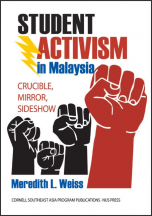Meredith L. Weiss, Student Activism in Malaysia. Crucible, Mirror, Sideshow.
Ithaca and Singapore: Cornell Southeast Asia Program Publications and NUS Press, 2011. Pp. vi, 302; list of acronyms, figure, index.
Reviewed by Leon Comber.
This is a fascinating book, which provides a detailed account of student activism in Malaysia, with its rise and demise, from the early twentieth century to more recent times. Beyond that, it provides a considerable amount of information about the development of Malayan and Malaysian politics and, to a lesser extent, Singapore politics too. However, it is not easy reading, as the publisher has used a small, rather eye-straining typeface and as it is packed with facts which are well documented from the extensive and impressive research that the author has carried out into English and Malay sources.
The author points to the heyday of the university protest movement being between 1967 and 1974, and based on the reviewer’s own knowledge of those times, this is probably correct.
It is interesting to see, too, reference to the earlier February 1948 “Conference of Youth and Students of South-east Asia Fighting for Freedom and Independence” which was held in Calcutta and sponsored by the communist-controlled World Federation of Democratic Youth and the International Union of Students (p. 37), as the influence that this conference may have had on student unrest in Chinese-medium schools in Malaya is often overlooked. It is perhaps worthy of further research by the author (especially in the Malayan Chinese-language press) in view of the important role that students played in the political upheaval then taking place inMalaya. It may well have been the reason that the Malayan Special Branch rather simplistically categorized in those days all student unrest as “communist” inspired.
Student politics were a cause of concern, too, to the authorities in the University of Malaya when it was located in Singapore in those early days, and in this connection the author mentions James Puthucheary and William Kuok Hock Ling (who used the communist alias of Peng Cheng), both well known student activists. Though the author does not refer to it, William Kuok–who went underground with the Communist Party of Malaya at the start of the Malayan Emergency in June 1948, edited a stenciled CPM English-language newssheet from the jungle, and was eventually killed by the security forces in an attack on a communist jungle camp in north Malaya–came from a well known and respected business family in Johor Bahru. His brother, Robert Kuok, is reputed to be the richest Chinese in Southeast Asia today.
It would be interesting if the author could elaborate further on the alleged penetration by intelligence agencies of the Malayan and Singapore student activist movement, especially as in 1974, S. Rajaratnam, Singapore’s foreign minister at the time, referred to CIA and KGB activity, and also on the increased interest being shown by the Singapore Police Special Branch into student affairs (p. 179).
The author refers to the turning point of Malaysian student activism having taken place in the 1970s, when the Malaysian government followed a policy of constraint and repression resulting from changes in Malaysia’s political regime and political culture. While this may well be correct, there are, too, other factors that should be taken into account. These include the tragic 13 May 1969 racial riots in Malaysia, which led to the introduction of the government’s New Economic Policy (NEP). The NEP attempted inter alia to adjust the racial balance of students entering universities. Prior to 1969 Chinese students accounted for approximately 70 per cent of the Malaysian undergraduate population, with a Malay student intake of approximately 30 per cent. But by the time the NEP began to take effect in the mid-1970s, the proportion had nearly reversed. Consequently, the university population became noticeably divided along racial and religious lines as each ethnic group had its own historical differences along lines of language, culture, religion, and geographical backgrounds. An increasing number of Malay students came from the more underprivileged sector of the population and were not inclined to take part in student political activities. They were more interested in studying, especially if they were on government scholarships, rather than participating in student politics. All of these factors would have had a depressing effect on the emergence of any strong student movement.
But to sum up, Dr Weiss’s book provides an excellent study of student activism in Malaysia and it will undoubtedly become one of the standard reference sources for this subject.
Leon Comber is Visiting Senior Research Fellow at the Institute of Southeast Asian Studies, Singapore. A Malaysian citizen, he fought in Burma as an officer in the Indian Army during the Second World War, commanded the Special Branch of the Malayan Police in Johor during the Emergency, served on the staff of Singapore’s first chief minister David Marshall, was director of Hong Kong University Press, and has written or edited two dozen books.
 Facebook
Facebook  Twitter
Twitter  Soundcloud
Soundcloud  Youtube
Youtube  Rss
Rss 